
Hungarian art
Encyclopedia
Hungarian art stems from the period of the conquest of the Carpathian basin by the people of Árpád in the 9th century. Prince Árpád also organized earlier people settled in the area.
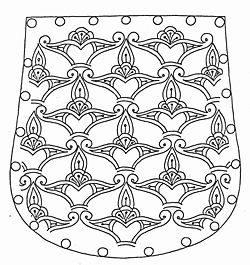

, named after King Attila's brother, though Priscus
rhetor, a 5th-century historian and ambassador of the Byzantine Empire
stated that the capital of the Huns was in the plains between the Danube
and Tisza
rivers. After the death of Attila in 453 the Lombards
and Gepids, and later the Avars
founded states here (568). This late Avar kingdom was defeated by the Franks
, and the Avars of Transdanubia were baptised. The first Hungarians came to the basin during the late 9th century.
produced a rich heritage, with noticeable parallels in the art of the Scandinavian Vikings and the Celts of Western Europe. The coronation mantle of King Stephen (crowned 1000 A. D.) is a particularly fine example from this period. This king stated that "10 villages should build a church" , and though several of his foundations were later famous in new guises, they all date back to the lex Stephani (law of King Stephen).
This king stated that "10 villages should build a church" , and though several of his foundations were later famous in new guises, they all date back to the lex Stephani (law of King Stephen). 
, Gyulafehérvár, Esztergom
, Pannonhalma
, while recently opened lapidariums at Pécs
, Veszprém
, and Eger
display remains from this period. Ruins of former royal houses at Tarnaszentmária, Feldebrő, and Szekszárd
, also show stylistic resemblances to contemporary architecture from the Caucasus.
Large-scale reconstructions were undertaken after the Mongolian wars of 1241-42. Many beautiful village churches survive from this periods, both round churches (Szalonna
, Kallósd
and Nagytótlak), and those with western tower and southern doorway at Nagybörzsöny
, Csempeszkopács
, Őriszentpéter
, Magyarszecsőd
, Litér
, Velemér
and Zalaháshágy
.
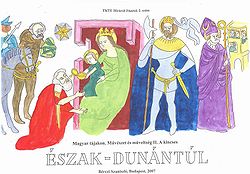
, Bártfa, Brassó
and Nagyszeben built their main squares in this style,which can also be seen in several rebuilt monasteries, for example (Garamszentbenedek). The now destroyed monastery of the Pauline Order
at Budaszentlőrinci was also built in this style.
The most renowned architect of this time was János Mester, a Franciscan
brother. His the largest churches are in Szeged-Alsóváros, in Farkas Street, Kolozsvár (Cluj), and in Nyirbátor. Perhaps the most famous Hungarian Gothic church of all is the Cathedral of St Elizabeth in Kassa
.

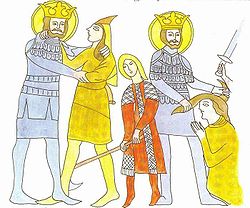
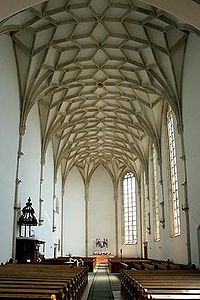
, and Louis The Great, King of Hungary and Poland were buried in the cathedral of Nagyvárad at the side of King Ladislaus.) Even today, after so many wars and so much destruction, there are about fifty churches where murals of the Saint Ladislaus legend
can be found.
 King Matthias Corvinus of Hungary
King Matthias Corvinus of Hungary
had close ties with Italy, and Italian influence is clearly evident in architectural complexes built during his reign, such as his palaces in Buda
and in Visegrad
. A recent exhibition at the mining Museum in Rudabánya
displayed the quality of Hungarian goldwork at this period in the golden forints made by Hungarian masters for the Russian Tsar Ivan III. 2008 saw the 550th anniversary of Matthias' reign, and many items from his library, the Bibliotheca Corvina (once the largest in Europe) were displayed in the National Széchényi Library in Buda Castle
link

 During the same period as the Wars against the Turks and the beginning of the Ottoman
During the same period as the Wars against the Turks and the beginning of the Ottoman
occupation, the Reformation led to a change of religious allegiance in about one third of Hungary. This time was also aperiod of renewal for churches in an architectural sense, with inner spaces displaying fresh and delicate ornamentation, particularly in the use of plant forms. "Cassette" ceilings are also characteristic of this period.
also led to great developments in the construction of Hungarian fortresses. Earlier fortresses had been built before the era of heavy artillery, but were now fortified to resist it. The best-known surviving fortresses from this period are those of Eger
, Nagyvárad, Nagykanizsa and Érsekújvár.
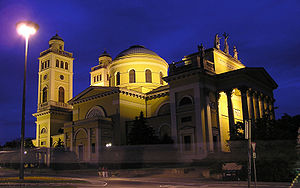 After the expulsion of the Turks in 1686, the new ruling house of the Habsburg
After the expulsion of the Turks in 1686, the new ruling house of the Habsburg
s brought with it the new Baroque style. Most of the early surviving buildings in Hungary today are in this style: not only churches, but also castles e.g. Fertőd
, town halls (Szeged
), monasteries (Zirc
), cathedrals (Kalocsa
), colleges (Eger
) and the royal palace at Buda
.
.
, who planned the Museum of Trade Art, The Hungarian Geological Institute, the town hall of Kecskemét
, and the Saint Ladislaus Church at Kőbánya, Budapest. Sometimes he is called the Hungarian Gaudi.
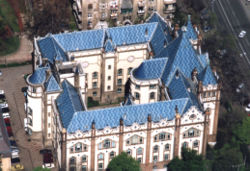


Horsemen in the Carpathian basin
Before the arrival of Árpád several other peoples from the steppe had founded states in the Carpathian basin. The capital of the Huns (Xiongnu in Chinese) was BudaBleda
Bleda was a Hun ruler, the brother of Attila the Hun.As nephews to Rugila, Attila and his elder brother Bleda succeeded him to the throne. His reign lasted for eleven years until his death. While it has been speculated throughout history that Attila murdered him on a hunting trip, no one knows...
, named after King Attila's brother, though Priscus
Priscus
Priscus of Panium was a late Roman diplomat, sophist and historian from Rumelifeneri living in the Roman Empire during the 5th century. He accompanied Maximinus, the ambassador of Theodosius II, to the court of Attila in 448...
rhetor, a 5th-century historian and ambassador of the Byzantine Empire
Byzantine Empire
The Byzantine Empire was the Eastern Roman Empire during the periods of Late Antiquity and the Middle Ages, centred on the capital of Constantinople. Known simply as the Roman Empire or Romania to its inhabitants and neighbours, the Empire was the direct continuation of the Ancient Roman State...
stated that the capital of the Huns was in the plains between the Danube
Danube
The Danube is a river in the Central Europe and the Europe's second longest river after the Volga. It is classified as an international waterway....
and Tisza
Tisza
The Tisza or Tisa is one of the main rivers of Central Europe. It rises in Ukraine, and is formed near Rakhiv by the junction of headwaters White Tisa, whose source is in the Chornohora mountains and Black Tisa, which springs in the Gorgany range...
rivers. After the death of Attila in 453 the Lombards
Lombards
The Lombards , also referred to as Longobards, were a Germanic tribe of Scandinavian origin, who from 568 to 774 ruled a Kingdom in Italy...
and Gepids, and later the Avars
Eurasian Avars
The Eurasian Avars or Ancient Avars were a highly organized nomadic confederacy of mixed origins. They were ruled by a khagan, who was surrounded by a tight-knit entourage of nomad warriors, an organization characteristic of Turko-Mongol groups...
founded states here (568). This late Avar kingdom was defeated by the Franks
Franks
The Franks were a confederation of Germanic tribes first attested in the third century AD as living north and east of the Lower Rhine River. From the third to fifth centuries some Franks raided Roman territory while other Franks joined the Roman troops in Gaul. Only the Salian Franks formed a...
, and the Avars of Transdanubia were baptised. The first Hungarians came to the basin during the late 9th century.
Art of the Conquest period
The People of Árpád in the 9th century used beautiful ornamental motifs to decorate both their dress and the trappings of their horses, the main motif being the palmette (see the above illustration). This style remained important in Hungary from the 9th to the 11th centuries, and similar motifs can be found in the contemporary decorative arts of the Caucasus, Iran and Middle-Asia.Arts in the Romanesque age
Descendants of Prince Árpád organized the medieval Hungarian Kingdom. During this period the combination of styles originating in the steppes with those of the European RomanesqueRomanesque art
Romanesque art refers to the art of Western Europe from approximately 1000 AD to the rise of the Gothic style in the 13th century, or later, depending on region. The preceding period is increasingly known as the Pre-Romanesque...
produced a rich heritage, with noticeable parallels in the art of the Scandinavian Vikings and the Celts of Western Europe. The coronation mantle of King Stephen (crowned 1000 A. D.) is a particularly fine example from this period.


Church architecture and sculpture
In spite of widespread destruction during the Turkish occupation (c1526-1686, and see below), Romanesque churches and other ecclesiastical buildings can be found throughout the Carpathian basin. Fine examples survive at SzékesfehérvárSzékesfehérvár
Székesfehérvár is a city in central Hungary and is the 9th largest in the country. Located around southwest of Budapest. It is inhabited by 101,973 people , with 136,995 in the Székesfehérvár Subregion. The city is the centre of Fejér county and the regional centre of Central Transdanubia...
, Gyulafehérvár, Esztergom
Esztergom
Esztergom , is a city in northern Hungary, 46 km north-west of the capital Budapest. It lies in Komárom-Esztergom county, on the right bank of the river Danube, which forms the border with Slovakia there....
, Pannonhalma
Pannonhalma
Pannonhalma is a town in western Hungary, in Győr-Moson-Sopron county with approximately 4,000 inhabitants. It is about from Győr. Archduke Otto Habsburg's heart is kept at the Pannonhalma Archabbey, while his body was laid at the Capuchin Crypt in the old Imperial capital of Vienna.-History:The...
, while recently opened lapidariums at Pécs
Pécs
Pécs is the fifth largest city of Hungary, located on the slopes of the Mecsek mountains in the south-west of the country, close to its border with Croatia. It is the administrative and economical centre of Baranya county...
, Veszprém
Veszprém
Veszprém is one of the oldest urban areas in Hungary, and a city with county rights. It lies approximately north of the Lake Balaton. It is the administrative center of the county of the same name.-Location:...
, and Eger
Eger
Eger is the second largest city in Northern Hungary, the county seat of Heves, east of the Mátra Mountains. Eger is best known for its castle, thermal baths, historic buildings , and red and white wines.- Name :...
display remains from this period. Ruins of former royal houses at Tarnaszentmária, Feldebrő, and Szekszárd
Szekszárd
Szekszárd is a city in Hungary and the capital of Tolna county. By population, Szekszárd is the smallest county capital in Hungary; by area, it is the second smallest -Location:...
, also show stylistic resemblances to contemporary architecture from the Caucasus.
Large-scale reconstructions were undertaken after the Mongolian wars of 1241-42. Many beautiful village churches survive from this periods, both round churches (Szalonna
Szalonna
Szalonna can refer to:*Szalonna , Hungarian bacon usually cooked on a stick over a campfire*Szalonna , in Hungary...
, Kallósd
Kallósd
Kallósd is a village in Zala county, Hungary.-References:...
and Nagytótlak), and those with western tower and southern doorway at Nagybörzsöny
Nagybörzsöny
Nagybörzsöny is a village in Pest county, Hungary.- Location :Nagybörzsöny is a village in the Börzsöny Mountains. In the vicinity we can find the National Park of Duna-Ipoly. The Börzsöny-creek flows through the village.- History :...
, Csempeszkopács
Csempeszkopács
-History:The village was created by uniting two villages, Csempeszháza and Kopács, in the 19th century. In 1910 the village had 313 inhabitants.-The Árpád Age Church:...
, Őriszentpéter
Oriszentpéter
- Geography :The town extends on the hills of the region Őrség, where the river Zala flows through. Zala has its source ca. 10 kilometers from here at Szalafő....
, Magyarszecsőd
Magyarszecsod
-Sightseeings:Two sister villages are Magyarszecsőd and Molnaszecsőd. Older church, from the Árpád age can be found in Magyarszecsőd. Beautiful southern doorway emphasize the artistic view of the southern facade, while wall columns decorate all the walls around. It has western tower, like it is at...
, Litér
Litér
- External links :*...
, Velemér
Velemér
- Parochial church :The beautiful building can be found in the forest at the end of the village. Its murals of late Árpád-age was painted by Aquila János. It was destructed by fire in the late 1800 years. Earlier it was measured and described by Rómer Flóris, member of the Hungarian Academy of...
and Zalaháshágy
Zalaháshágy
Zalaháshágy is a village in Zala County, in Hungary.-Setting, geography:Zala-hills form a rivercut hilly region in West Hungary. Zala river cross over the region. The system of riverbeds and valleys were formed in the Cainozoic geological period....
.

Gothic art
The Gothic style reached Hungary in the late 14th century, and continued throughout the reigns of the Anjou, Luxembourg, and Jagello kings. Wealthy mining towns have built them on their main square like as at such as KassaKassa
Kassa can either mean:* Košice a town in Slovakia*Kassa, Mali* Kassa A Dutch consumer protection TV program* Kassa an African ruler* Iles de Los*Kassa, Italian Artist and Designer, http://www.kassa.it...
, Bártfa, Brassó
Brassó
Brassó may refer to:* Brassó, the Hungarian name for Braşov, Romania* Brassó County, a county of the Kingdom of Hungary from 1876 to 1920 with the above city as county seat...
and Nagyszeben built their main squares in this style,which can also be seen in several rebuilt monasteries, for example (Garamszentbenedek). The now destroyed monastery of the Pauline Order
The Order of Saint Paul the First Hermit
The Pauline Fathers a Hungarian order of the Roman Catholic Church, are more formally known as The Order of Saint Paul the First Hermit .This name is derived from the hermit Saint Paul of Thebes , canonized in 491 by Pope Gelasius I...
at Budaszentlőrinci was also built in this style.
The most renowned architect of this time was János Mester, a Franciscan
Franciscan
Most Franciscans are members of Roman Catholic religious orders founded by Saint Francis of Assisi. Besides Roman Catholic communities, there are also Old Catholic, Anglican, Lutheran, ecumenical and Non-denominational Franciscan communities....
brother. His the largest churches are in Szeged-Alsóváros, in Farkas Street, Kolozsvár (Cluj), and in Nyirbátor. Perhaps the most famous Hungarian Gothic church of all is the Cathedral of St Elizabeth in Kassa
Kassa
Kassa can either mean:* Košice a town in Slovakia*Kassa, Mali* Kassa A Dutch consumer protection TV program* Kassa an African ruler* Iles de Los*Kassa, Italian Artist and Designer, http://www.kassa.it...
.



Sculptures and paintings
The rich heritage of paintings in Hungary originated with the royal houses of Luxemburg and Anjou, that both esteemed the earlier king Ladislaus I. (Both Sigismund of Luxemburg, King of Hungary and Holy Roman EmperorSigismund, Holy Roman Emperor
Sigismund of Luxemburg KG was King of Hungary, of Croatia from 1387 to 1437, of Bohemia from 1419, and Holy Roman Emperor for four years from 1433 until 1437, the last Emperor of the House of Luxemburg. He was also King of Italy from 1431, and of Germany from 1411...
, and Louis The Great, King of Hungary and Poland were buried in the cathedral of Nagyvárad at the side of King Ladislaus.) Even today, after so many wars and so much destruction, there are about fifty churches where murals of the Saint Ladislaus legend
Saint Ladislaus legend
An episode from the Legend of Saint Ladislaus provided the subjects for numerous murals painted in medieval churches in Hungary during the 14th to 16th century.-Historical background:Ladislaus I of Hungary was a chivalrous king in Hungary in the 11th century...
can be found.
Renaissance

Matthias Corvinus of Hungary
Matthias Corvinus , also called the Just in folk tales, was King of Hungary and Croatia from 1458, at the age of 14 until his death...
had close ties with Italy, and Italian influence is clearly evident in architectural complexes built during his reign, such as his palaces in Buda
Buda
For detailed information see: History of Buda CastleBuda is the western part of the Hungarian capital Budapest on the west bank of the Danube. The name Buda takes its name from the name of Bleda the Hun ruler, whose name is also Buda in Hungarian.Buda comprises about one-third of Budapest's...
and in Visegrad
Visegrad
Visegrad is a name of Slavic origin meaning "the upper castle" or "the upper settlement/town/fortification".There are several places that may be spelt Visegrad in English:-Places:* Višegrad, a town in Bosnia and Herzegovina...
. A recent exhibition at the mining Museum in Rudabánya
Rudabánya
- External links :* *...
displayed the quality of Hungarian goldwork at this period in the golden forints made by Hungarian masters for the Russian Tsar Ivan III. 2008 saw the 550th anniversary of Matthias' reign, and many items from his library, the Bibliotheca Corvina (once the largest in Europe) were displayed in the National Széchényi Library in Buda Castle
Buda Castle
Buda Castle is the historical castle and palace complex of the Hungarian kings in Budapest, first completed in 1265. In the past, it was also called Royal Palace and Royal Castle ....
link
Reformation


Ottoman Empire
The Ottoman EmpireIt was usually referred to as the "Ottoman Empire", the "Turkish Empire", the "Ottoman Caliphate" or more commonly "Turkey" by its contemporaries...
occupation, the Reformation led to a change of religious allegiance in about one third of Hungary. This time was also aperiod of renewal for churches in an architectural sense, with inner spaces displaying fresh and delicate ornamentation, particularly in the use of plant forms. "Cassette" ceilings are also characteristic of this period.
Architecture of Fortresses
The wars against the Ottoman EmpireOttoman Empire
The Ottoman EmpireIt was usually referred to as the "Ottoman Empire", the "Turkish Empire", the "Ottoman Caliphate" or more commonly "Turkey" by its contemporaries...
also led to great developments in the construction of Hungarian fortresses. Earlier fortresses had been built before the era of heavy artillery, but were now fortified to resist it. The best-known surviving fortresses from this period are those of Eger
Eger
Eger is the second largest city in Northern Hungary, the county seat of Heves, east of the Mátra Mountains. Eger is best known for its castle, thermal baths, historic buildings , and red and white wines.- Name :...
, Nagyvárad, Nagykanizsa and Érsekújvár.
Baroque reconstruction

Habsburg
The House of Habsburg , also found as Hapsburg, and also known as House of Austria is one of the most important royal houses of Europe and is best known for being an origin of all of the formally elected Holy Roman Emperors between 1438 and 1740, as well as rulers of the Austrian Empire and...
s brought with it the new Baroque style. Most of the early surviving buildings in Hungary today are in this style: not only churches, but also castles e.g. Fertőd
Fertod
Fertőd is a town located in the Győr-Moson-Sopron county of Hungary, not far from Austria. Fertőd was formed when the towns of Eszterháza and Süttör were unified, in 1950....
, town halls (Szeged
Szeged
' is the third largest city of Hungary, the largest city and regional centre of the Southern Great Plain and the county town of Csongrád county. The University of Szeged is one of the most distinguished universities in Hungary....
), monasteries (Zirc
Zirc
-Attractions:*Zirc Abbey, a Cistercian abbey*Zirc Arboretum*Bakony Museum of Natural Sciences, situated in the territory of Zirc Abbey-External links:*...
), cathedrals (Kalocsa
Kalocsa
Kalocsa is a town in Bács-Kiskun county, Hungary. It lies 88 miles south of Budapest. It is situated in a marshy but highly productive district, near the left bank of the Danube River. Historically it had greater political and economic importance than at present.Kalocsa is the Episcopal see...
), colleges (Eger
Eger
Eger is the second largest city in Northern Hungary, the county seat of Heves, east of the Mátra Mountains. Eger is best known for its castle, thermal baths, historic buildings , and red and white wines.- Name :...
) and the royal palace at Buda
Buda
For detailed information see: History of Buda CastleBuda is the western part of the Hungarian capital Budapest on the west bank of the Danube. The name Buda takes its name from the name of Bleda the Hun ruler, whose name is also Buda in Hungarian.Buda comprises about one-third of Budapest's...
.
Neo-classicism
After the Age of Reform, in the early 19th century ancient Greek traditions were revived, with the consequent construction of such neo-Classical buildings as the Hungarian National MuseumHungarian National Museum
- History:The Hungarian National Museum is said to have been founded in 1802 when Count Ferenc Széchényi set up the National Széchényi Library. This would then be followed a year later by the donating of a mineral collection by Széchényi’s wife. This led to the creation of the Hungarian National...
.
Secessionism or Jugendstil
One of the greatest architects of his age was Ödön LechnerÖdön Lechner
Ödön Lechner was a Hungarian architect, nicknamed the "Hungarian Gaudí".Lechner was one of the early representatives of the Hungarian Secession movement, called szecesszió in Hungarian, which was related to Art Nouveau and Jugendstil in the rest of Europe...
, who planned the Museum of Trade Art, The Hungarian Geological Institute, the town hall of Kecskemét
Kecskemét
Kecskemét is a city in the central part of Hungary. It is the 8th largest city of the country, and the county seat of Bács-Kiskun.Kecskemét lies halfway between the capital Budapest and the country's third-largest city, Szeged, 86 kilometres from both of them and almost equal distance from the two...
, and the Saint Ladislaus Church at Kőbánya, Budapest. Sometimes he is called the Hungarian Gaudi.

Further reading
- [Dercsényi D., Zádor A. (1980): Kis magyar művészettörténet (A honfoglalás korától a XIX. század végéig). Little Hungarian Art History. (Képzőművészeti Alap Kiadóvállalata, Budapest]
- [Szentkirályi Z. Détshy M. (1986): The Short history of Architecture. I-II. Műszaki, Budapest]
- [Radocsai Dénes: Magyarországi reneszánsz művészet. The Hungarian Renaissance Art. Képzőművészeti Alap Kiadóvállalata, Budapest]
- [Aradi N. (főszerk.) (Ész. N.): A művészet története Magyarországon. The History of Art in Hungary, Gondolat, Budapest]
- [Fülep L. (főszerk.) (Ész. N.): A magyarországi művészet története. The History of Art in Hungary, Budapest]
- [Gerevich T. (1938): Magyarország románkori emlékei. Romanesque art heritage of Hungary. Királyi Magyar Egyetemi Nyomda, Budapest]
- [Henszlmann I. (1876): Magyarország ó-keresztyén, román és átmeneti stylü mű-emlékeinek rövid ismertetése. Királyi Magyar Egyetemi Nyomda, Budapest]
- [Marosi E. (1972): A román kor művészete. The Art of the Romanesque Age. Corvina Kiadó, Budapest]
- [László Gy. (1974): A népvándorláskor művészete Magyarországon. The art of the great migration times in Hungary. Corvina, Budapest]
- [Huszka J. (1930): A magyar turáni ornamentika története. The History of the Hungarian Turanian Ornamental Art. Pátria, Budapest]
- [Bakay K. (1997, 1998): Őstörténetünk régészeti forrásai. Sources ofour ancient history. I. II. Miskolc]
- [Tombor I. (1968): Magyarországi festett famennyezetek és rokonemlékek a XV-XIX. századból. Painted wood ceiling and related heritage from Hungary, in the XV-XIX Centuries. Akadémiai, Budapest]
- [Domanovszky Gy. (1981): A magyar nép díszítőművészete I-II. The Ornamental Art of the Hungarian People. Akadémiai, Budapest]
- [Bérczi Sz. (1987): Szimmetriajegyek a honfoglalás kori palmettás és az avar kori griffes-indás díszítőművészetben. Cumania. 10. Symmetry in Ornamental Art of the Palmette art of Conquesting Hungarians and the Griffin-and-Tendrill art of the Avar-Onogurians. (Bács-Kiskun Megyei Múzeumi Évkönyv), 9-60. old.]
- [László, Gy. (1943): A Kolozsvári testvérek Szent György lovas-szobrának lószerszáma. The Horse Mount of the Statue of St. George Made by the Kolozsvári Brothers. Egyetemi Nyomda, Kolozsvár]
- [László, Gy. (1943b): Der Grabfund von Koroncó und der altungarische Sattel. Archaeologia Hungarica, XXVII. Budapest]
- [Gombrich, E (1986): A művészet története, The History of Arts. Gondolat Kiadó, Budapest]
- [Fodor I. (1996): A honfoglaló magyarság. The Conquesting Hungarians. Magyar Nemzeti Múzeum, Budapest]
- [Gerő L. (szerk.) (1975): Várépítészetünk. Architecture of t our fortresses and cestles. Műszaki, Budapest]
- [Gervers-Molnár V. (1972): A középkori Magyarország rotundái. Rotundas in the Medieval Hungary. Akadémiai, Budapest]
- [Lükő G. (1942): A magyar lélek formái. The forms of the Hungarian Soul. Exodus, Budapest]
- [Ortutay Gy. (főszerk.) (1977–1982): Magyar Néprajzi Lexikon. Encyclopedia of the Hungarian Ethnography. Akadémiai Kiadó, Budapest]
- [Szőnyi O. (É.n.): Régi magyar templomok. Alte Ungarische Kirchen. Anciennes églises Hongroises. Hungarian Churches of Yore. A Műemlékek Országos Bizottsága. Mirályi Magyar Egyetemi Nyomda, Budapest. ]
- [Zolnay L. (1977): Kincses Magyarország. The Treasuries of Hungary. Magvető, Budapest]
External links
- http://www.sulinet.hu/tovabbtan/felveteli/ttkuj/12het/muvtori/muvtori12.html
- http://www.sulinet.hu/tovabbtan/felveteli/ttkuj/15het/muvtori/muvtori15.html
- http://www.sulinet.hu/tovabbtan/felveteli/ttkuj/17het/muvtori/muvtori17.html

